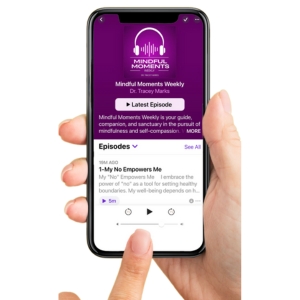Breaking the Cycle of Regret
Have you ever told yourself, “Okay, this is the last time”—only to find yourself doing that very thing again the next day?
Products To Support You

Mindful Moments Subscription

Positive Prompts 22oz skinny tumbler
Understanding and Breaking Bad Habits
Whether it’s scrolling late at night, snacking when you’re not even hungry, or checking your phone every few minutes, bad habits have a way of pulling us back in. You know what you should do, but somehow, it doesn’t stick.
Here’s why: Breaking bad habits isn’t about willpower. It’s not a character flaw. It’s about how your brain is wired—and once you understand that, you can start working with your brain instead of fighting it.
In this post, we’ll bust some common myths about habit change, explore the deeper drivers that keep habits alive, and walk through brain-based strategies that actually work.
Myth #1: “I just need more willpower.”
Willpower is a limited resource. It runs out.
Every decision you make throughout the day—what to eat, when to respond to a text, whether or not to work out—depletes a little bit of your mental energy. This is known as ego depletion, and it’s why you can resist temptation all day long… and then find yourself knee-deep in snacks at 9 p.m.
Neurologically, willpower is controlled by the prefrontal cortex—the part of your brain responsible for planning and self-control. But your habits live in a different place altogether: the basal ganglia, your brain’s autopilot system.
So when you try to outmuscle a habit with willpower, you’re asking your executive brain to override your automatic brain. And over time, the automatic brain usually wins.
What works better? Change your environment.
Simple adjustments to your surroundings can break the loop faster than relying on discipline alone.
Myth #2: “If I know it’s bad for me, I should be able to stop.”
This one feels logical. But the brain doesn’t always operate on logic—it operates on reward.
Even if you know a habit is harmful, that doesn’t mean your brain will automatically reject it. That’s because your brain heavily favors immediate rewards over long-term outcomes.
So in the moment, your brain isn’t thinking about your health goals or future stress levels. It’s thinking, What feels good right now? That’s the domain of dopamine, the brain’s reinforcement signal.
This is why knowledge alone isn’t enough. You have to outsmart your reward system, not just appeal to it.
Myth #3: “I just need to eliminate the habit completely.”
Cutting off a bad habit sounds appealing—but elimination leaves a gap. And your brain doesn’t like gaps.
Habits are built around neural pathways that expect a certain reward after a cue or trigger. If you try to quit cold turkey without replacing the habit, your brain still expects that reward and will keep pulling you back.
Substitution works better than elimination. If you check social media when bored, try replacing it with a walk, a short call with a friend, or even a more productive app. You’re not just removing stimulation—you’re redirecting it.
The Identity Trap: Why Behavior Change Requires a Self-Concept Shift
Behind every habit is a story we tell ourselves.
These aren’t just descriptions—they’re predictions. They tell your brain what to expect from you next.
When your identity is tied to your habit, changing the habit can feel like changing who you are. But that identity isn’t fixed. It can evolve.
Try reframing how you describe yourself:
Small changes in language help create alignment between the you now and the you you’re becoming.
Want to go deeper on identity change? Check out my Unlock Your Story Digital Workbook—it’s a guided resource to help you explore the beliefs that shape your behavior.
Cognitive Distortions That Keep Bad Habits Alive
Certain thought patterns quietly support the habits we’re trying to break. These are cognitive distortions—mental shortcuts that sound convincing but lead to poor decisions.
Here are a few to look out for:
To interrupt these patterns, pause and ask yourself: “Is this thought helping me become who I want to be?” This creates space between the urge and the action—giving your logical brain time to intervene.
Five Brain-Based Strategies for Breaking Bad Habits
Once you’re aware of the myths and mental traps, you can start using strategies that align with how your brain actually works.
1. Environment Redesign
Make the habit harder to access. Add friction.
2. Implementation Intentions
Use “if-then” planning to stay on track.
3. The Replacement Rule
Pick a substitute behavior that meets the same need.
4. Habit Stacking
Attach a new habit to something you already do.
5. The 10-Minute Rule
When an urge hits, wait 10 minutes. Most cravings fade quickly. Giving yourself that window allows your rational brain to re-engage before the habit takes over.
Why Bad Habits Stick
Because your brain doesn’t distinguish between helpful and unhelpful behaviors, it reinforces anything that delivers a sense of reward. Habits tied to dopamine-rich rewards—like sugar, social media, or nicotine—are especially sticky. Dopamine is often misunderstood as the “pleasure” chemical, but it’s more accurately a reinforcement chemical. It signals to your brain, “That worked—do it again.”
This is why habits can feel so hard to break. When you’re relying on willpower alone, you’re asking your prefrontal cortex to outcompete your brain’s reward system and autopilot processes. And over time, the automatic systems usually win.
What About Setbacks?
Setbacks aren’t failure. They’re data.
Each time you return to your new habit after a slip, you’re strengthening the right pathway. The slip doesn’t define you—the return does.
When a setback happens, ask:
This reflective process puts you back in a position of learning and growth.
Final Thoughts
Breaking bad habits isn’t about moral strength. It’s about:
In the next post, we’ll explore how to build positive habits that stick—and how to make them feel natural instead of forced.
But for now, here’s something to try:
Pick one habit you’re working on and identify the distortion you use to justify it.
Is it “just this once”? “I’ll start Monday”?
Notice when it shows up—and you’ll be one step closer to changing it.

